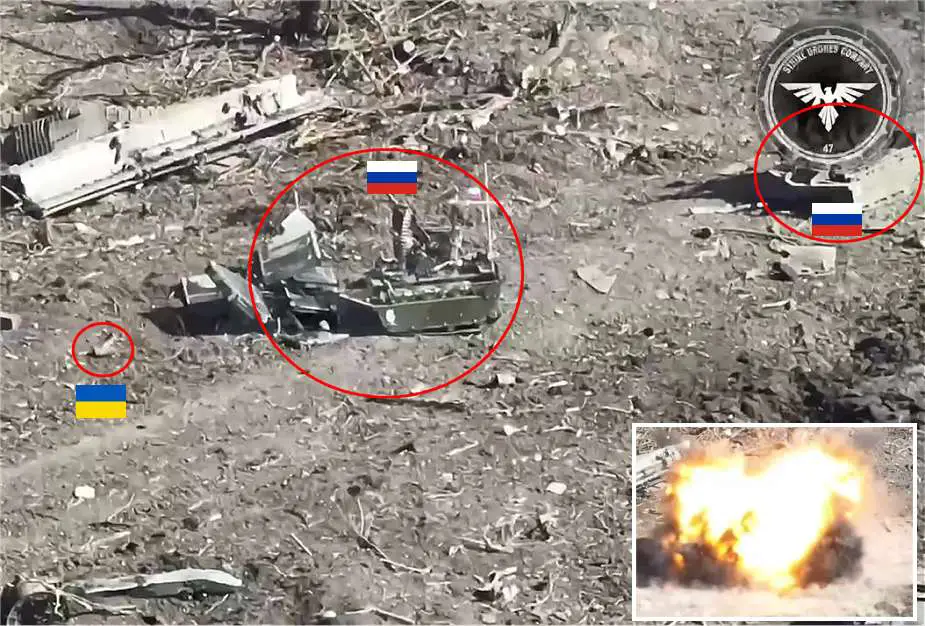- Army
- Conflicts in the world
- Israel - Iran conflict 2025
- Pakistan - India Conflict 2025
- Russia Ukraine War 2022
- Libya conflict day by day
- HAMAS - Israel War 2023
- Operation Serval in Mali French Army
- Sangaris operation Central African Republic
- Sangaris opération militaire République Centreafrique
- Ukraine - Russia conflict
- Syria conflict news
- Defence & Security Industry Technology
- Armies in the world
- Analysis Defense and Security Industry
- Conflicts in the world
- Navy
- Air
First Historical Drone Combat Between Russian Ground Robots and Ukrainian FPV Aerial Drone
The Russian-Ukrainian conflict witnessed its first known drone combat on March 29, 2024, a confrontation that underscored the evolving nature of unmanned warfare. This could be the first combat between land and air drones in history. Images released on Telegram documented this historic encounter, involving two Russian unmanned ground vehicles (UGVs) armed with an AGS-17 automatic grenade launcher and a TM-62 mine-laying system. These formidable machines were subsequently destroyed by a Ukrainian First Person View (FPV) drone, marking a significant moment in the use of unmanned systems in combat.
Follow Army Recognition on Google News at this link

A Ukrainian FPV First Person View aerial drone strikes a Russian UGV Unmanned Ground Vehicle. (Picture source Screen shot video footage)
This landmark drone combat on March 29, 2024, not only signifies the evolution of unmanned warfare in the Ukraine conflict but also stands as a testament to the escalating sophistication in drone engagements. Before this significant encounter, the battlefield had seen a different kind of unmanned confrontation. FPV drones from both sides had previously targeted each other's ground-based drones. However, these engagements involved simpler, radio-controlled "carts" that were primarily used for transporting ammunition. These initial forays into unmanned combat were rudimentary yet innovative, setting the stage for the advanced drone-on-drone warfare that would follow.
The transition from using these basic radio-controlled carts to deploying highly sophisticated unmanned ground vehicles (UGVs) equipped with automatic grenade launchers and mine-laying systems marks a significant leap in military strategy and technology. It reflects a deeper understanding and integration of unmanned systems in battlefield tactics, highlighting how both Russian and Ukrainian forces are pushing the boundaries of conventional warfare.
The destruction of the Russian UGVs by a Ukrainian FPV drone not only showcases the tactical flexibility and precision that drones offer but also illustrates the rapid pace at which unmanned technology is being adopted and adapted for combat scenarios. This evolution from simple ammunition carts to complex, weaponized drones encapsulates the transformative impact of technology on modern warfare, signaling a new era of engagement where unmanned systems play a central role.
The AGS-17 is an automatic grenade launcher developed in the Soviet era, renowned for its firepower and ability to deliver high-explosive fragmentation rounds at a rapid pace. It has been a critical asset in various conflicts, offering significant support to ground forces by suppressing enemy positions from a distance.
Complementing the AGS-17, the TM-62 series represents a range of anti-tank mines designed to counter armored threats. These mines can be deployed in multiple ways, including through specialized mine-laying systems, making them versatile tools for controlling key areas and denying enemy movement.
This encounter south of Avdiivka highlights the innovative approaches both Russian and Ukrainian forces are taking in leveraging unmanned technologies. The Russian army's 87th Rifle Regiment, recognized for utilizing UGVs built with indigenous capabilities, demonstrates the strategic importance of these systems. These UGVs not only support troops in combat but also play crucial roles in logistics, such as facilitating casualty evacuations.
The use of an FPV drone by Ukrainian forces to neutralize the threat posed by these armed UGVs showcases the tactical flexibility drones offer. FPV drones, piloted remotely with a first-person viewpoint, provide a unique advantage in reconnaissance, combat, and surgical strikes, allowing operators to engage targets with precision while minimizing exposure to danger.
This engagement signifies a shift towards more autonomous forms of warfare, where unmanned systems play pivotal roles on the battlefield. As both sides continue to explore the capabilities and limitations of these technologies, the conflict in Ukraine serves as a testing ground for the future of military operations, emphasizing the increasing reliance on drones and robotic systems in modern combat scenarios.
News Russia Ukraine War


























